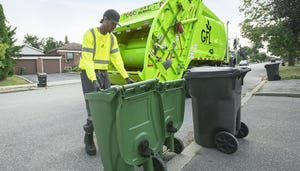Behind the Industry’s Effort to Improve Driver Safety, One State at Time
David Biderman would like people to think of garbage trucks more like they think of school buses.
“You see a school bus and say, oh, there are kids around, I have to drive slower,” says the vice president of government affairs for the Washington-based National Waste & Recycling Association (NWRA) and a longtime safety proponent for the association. The goal is, “can we get people to think that way around garbage trucks as opposed to thinking they’re just an obstacle that they need to speed up to get around.”
The cornerstone of the association’s safety push is to lobby states to pass into law some form of its Slow Down to Get Around concept, which requires that drivers to be more aware and cautious around waste and recycling trucks.
Currently, five states have adopted such laws: Michigan, Wisconsin, Alabama, Florida and West Virginia. It’s on the radar in other legislatures.
“We’ve seen great progress in Virginia, Georgia and Indiana, and have introduced bills in several other states,” Biderman says. “We are confident that a slow down to get around bill will be signed into law in several states in 2015.” Kansas, Illinois and North Carolina are other potential states where there might be bills passed.
The Silver Spring, Md.-based Solid Waste Association of North America (SWANA) also has been supportive of the lobbying efforts.
The laws follow two basic models. One calls for higher penalties for drivers striking sanitation workers. In the other, drivers are required to slow down (for example, to 10 mph) or move over a lane when passing waste collection trucks.
Biderman says the preferred approach depends on a variety of factors. “Usually these bills are amendments to existing laws, and so the structure of the existing state law matters,” he says.
Government data clearly shows that waste and recycling is a dangerous profession. The Labor Department reported that for 2013 refuse and recyclable material collectors had the fifth most dangerous job in 2013, as compared to sixth the year before. The fatal work injury rate in 2013 was 33.0 per 100,000 full-time equivalent workers.
Michigan was the first state to pass a sanitation safety driver bill in 2009, but other states have enacted laws in recent years. But it’s difficult to surmise if the laws have had an impact yet. “I think it’s too early to draw any sort of statistical correlation or causation between the enactment of a Slow Down to Get Around bill and a reduction in the frequency of struck-by accidents,” Biderman says.
And there are confounding variables, such as driver use of mobile phones, and laws outlawing mobile phone use while driving. And the population is aging as well, which also could affect conclusions about driver tendencies.
“However, [Slow Down laws] certainly have raised awareness among elected officials, the general public and our workforce about this important safety hazard,” he says. “That’s part of what we’re doing here; by putting the stickers on the trucks, by passing laws like this, we’re not just communicating to motorists, we’re communicating to workers, and letting them know that there’s a safety hazard out there. And they need to be thinking about that when their feet are on the street.”
Bright Side of the Road
Florida is one of the most recent states to pass a Slow Down law, just last October. Kenya Cory agrees it’s too early to see any tangible change, but definitely time to ramp up education. She’s a lobbyist for the Florida chapter of the NWRA, as well as executive director for the Florida Recycling Partnership.
Florida is a state that had a Move Over Act already in place to address fire, rescue, safety, police, emergency vehicles and even tow trucks. Cory and other proponents got the legislature to add in solid waste and utility vehicles.
“What we’re trying to do now is say, ‘OK, there is a law here now,’” Cory says. “It’s up to us to help the Department of Highway Safety and Motor Vehicles to educate people about it.”
Cory says it was a big challenge to get the bill passed. The state senate indicated it didn’t think the addition of waste workers was necessary, and the highway department feared it would detract from the original intent of the bill.
And, “Florida, I hate to say, has just been woefully behind on safety issues,” she says. It was the 48th state to pass a law prohibiting texting while driving, for example. “But once we get people educated about the importance of doing it, then it resonates. And they start understanding why we need those special laws.
“It’s just not a one-time hit, it’s going to have to be ongoing,” she adds. “It’s like when you have a driver on a truck, it’s practice, practice, practice before they really get it ingrained in their mind and their way.”
Cory currently is lobbying on the texting law to increase it from a secondary offense to a primary one. Currently, police have to pull drivers over for another violation first.
And that’s certainly an issue affecting waste and recycling worker safety as well. One legislator pointed out to Cory that waste workers already aren’t allowed to text and drive, because it involves commercial vehicles. “But what stops that person from running into our truck while they are texting and driving?” she says. “So we’re trying to combine all that.”
New York City doesn’t have a waste truck awareness law, but when the movement started gaining momentum six to eight years ago the Department of Sanitation put “Slow Down To Get Around” stickers on each of its garbage trucks, Biderman says.
The city’s sanitation department doesn’t have any data tracking the effect of the stickers. But the city has been active in safety training in other ways as well, says Kathy Dawkins, with public affairs for the department, in an e-mail. The department’s Division of Safety and Training regularly educates employees on safe practices. The department also operates an Accident Reduction Initiative program that promotes both safe driving techniques as well as safe work practices.
Biderman says the association and other safety advocates have talked with legislators about various slow-down options, from driving a certain number of miles below the speed limit or not passing a stopped garbage truck above a certain speed. “Because that way if an unfortunate incident occurs, the impact would be lesser, and hopefully no one would get killed,” he says. “We’re both trying to reduce frequency, and we’re also trying to reduce … severity.”
Certifiably Safe
The NWRA also has taken another approach to improve safety through a certification effort, and its first initiative was Certified Safe Drivers, launched last June, for waste and recycling truck operators. Future certification programs may include those for front-line supervisors; facilities such as material recovery facilities (MRFs); or processes such as recycling.
A person who passes the certification exam, which consists of 75 multiple-choice questions, demonstrates that they have a foundational knowledge of industry best practices in driver safety, said Tiffany Jones, certification director for NWRA. Certified drivers show a base-level knowledge proficiency in the elements of commercial driving, safety protocol, procedure, regulations, standards and performance.
One safety initiative that raised concerns with the NWRA has been a proposal by the California Occupational Safety and Health Standards Board (Cal/OSHA) to reduce the allowable speed for right-side drive waste collection vehicles. The association feared that it instead would undercut national momentum in improving worker safety in the waste industry.
“No federal, state or local government safety fact sheet concerning the industry has ever identified falling out of a right-side drive vehicle as a priority concern,” Biderman said in December, and he reiterated that recently. “Cal/OSHA’s proposed revisions are contrary to national best practices for such vehicles and drivers as set forth by the American National Standards Institute (ANSI) and undercut the ANSI Z245 safety standards.”
In late March, Cal/OSHA’s standards board adopted its proposal. Peter Melton, spokesman for Cal/OSHA, provided an e-mail statement regarding the state’s perspective: “In response to the speed limit question, the board adopted the ANSI 245.1 standard’s recommended speed limit of 20 mph during collection from the right-hand, or secondary, position.” The rulemaking package was submitted to the Office of Administrative Law for approval.
Biderman’s initial reaction, provided in an e-mail, was, “We are reviewing the board’s decision and (are) contemplating next steps.”
But regardless of the approach or the issue, improving waste and recycling worker safety is the big prize. Biderman says patience is a key to success.
“It’s about awareness. This is a long-term project. This is not something where we’re expecting immediate results. But it is something we’re dedicating a significant amount of resources to. Because there’s nothing more important.”
About the Author(s)
You May Also Like


